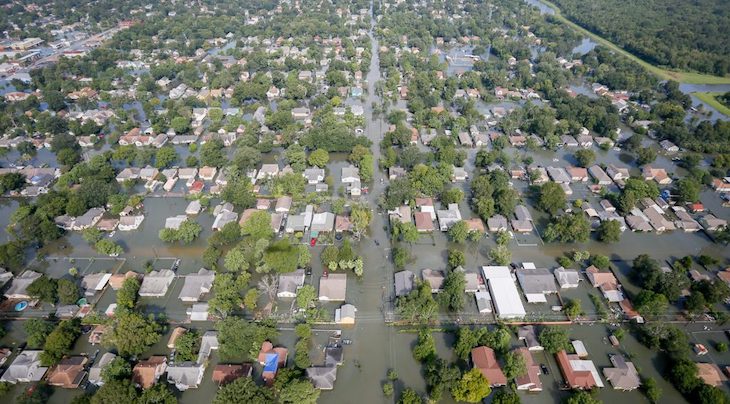The orchestrator
Turner has a lot going for him. He has a great education, which includes a degree from Harvard Law. He has had tremendous influence in society resulting from his current position and other state-level political office experience. He works in one of the country's largest urban areas, and he leads an organization that has a history of resilience and a culture of reciprocity. He even enjoys an enviable social media following for someone approaching retirement age.
Yet, Turner currently faces major challenges with both historical and future significance. He leads an organization at a time of catastrophe and has to deal with social-media-amplified rumor mills disrupting his ability to orchestrate a network of internal and external resources. He must address the concerns of his “customer” base, which include both loss of life and property.
Since he has officially declared Houston again “open for business” in the aftermath of Hurricane Harvey, now is a good time to reflect on lessons learned from response and recovery efforts. In what ways was Mayor Turner's approach to galvanizing rescue and relief efforts a useful model for leaders attempting to build community resilience in their locales? What key resilience takeaways can other leaders gain from Houston's tragic loss?
The challenge
When diverse organizations have to collaborate, tensions can rise over scarce resources and conflicting goals, especially under conditions of hazardous uncertainty. Uncertainty in particular plagued Houstonians, both in terms of accurately anticipating Harvey's path and estimating its intensity (even for the National Hurricane Center). Seasoned crisis professionals like Judge Ed Emmett, the top emergency management official in Harris County, proclaimed, “We've never seen water like this before.” In response, Turner acknowledged the departure from normalcy in multiple statements and expressed empathy toward those whose homes had not flooded in past storms and decided to remain in place to protect their property.
The twin affects of threat uncertainty and departure from normalcy can create great anxiety in communities and often trigger counterproductive responses like amplified rumors mills and bandwagon panic runs on supplies.
Despite the enormous outpouring from public, corporate, and individual donations, resource allocation created a challenge for Turner. One issue with resources was akin to a “last mile” delivery problem, where water-flooded transportation routes and call-flooded communication lines bottlenecked getting rescue and relief assets to specific victims. Some transportation routes are expected to be submerged for weeks–possibly months. And the Houston Police Department hotline to coordinate volunteers faced a backlog that hindered helpers.
Network orchestration under conditions of resource scarcity and value uncertainty is challenging enough, but add to that potential goal conflict across stakeholders and matters get even worse. Turner faced two very challenging decisions with Harvey's onslaught:
First, whether to order mandatory evacuations presented him with a gut-wrenching, wicked problem without “one right answer,” but also with potentially devastating consequences. Should he have residents shelter in place and face the possibility of a Hurricane Katrina repeat of New Orleans? Or should he have residents mass-evacuate and face the possibility of a Hurricane Rita repeat, when more Houston citizens died in the evacuation than the storm surge? In the end, Turner decided not to order a citywide evacuation, but instead, a week after initial landfall, he “strongly urged” the evacuation of residents in targeted neighborhoods with water still in their homes. The request was posted across social media platforms, such as private neighborhood social network platform Nextdoor, and included a video for a press conference with addresses from the mayor, the police chief, and the fire chief. All conveyed the same message: first responders were greatly stressed and could not provide water taxi service for two more weeks, the time estimated for receding waters.
Turner's second gut-wrenching decision involved controlled water releases. Two reservoirs overflowed at record levels, which led to his choice to proactively release water over time. He was told doing so would spare the dams protecting Houston residents in general, but it would also guarantee the flooding of certain Houston neighborhoods. He emotionally acknowledged that he understood residents' concerns but would follow the advice of civil engineers to conduct the controlled water releases, with estimated effects on neighborhoods totaling 15,000 homes. The interests of the many would supplant the interests of the few.
The lessons learned?
Turner's predicament and response provide future network orchestrators with lessons learned for leading through and beyond other crisis episodes. In general, network orchestrators like Turner play a critical role in converting a crisis into a window of opportunity for collaboration–the type of collaboration that helps a community bounce back and adapt to the new normal they face.
We can think about the role of network orchestrators comprising three functions: brokering, bridging, and buffering. Brokering involves bringing parties together to set future partnering in motion. Bridging involves bringing parties together and maintaining that partnership through direct, ongoing involvement of the orchestrator. Buffering involves separating parties to reduce the effects of one party on another (generally overwhelmed or resource-strapped) party.
Key resilience takeaways
So what are some applications to corporate resilience and network orchestration?
- Leverage crisis events to marshal resources, experiment with new partnerships, and restore fragile relationships–all for both immediate needs and long-term adaptation.
- Boost social cohesion by simultaneously restoring trust in institutions and encouraging peer-to-peer support.
- Help your team embrace their new normal by empathizing with their pain while exhorting them to persevere, which requires leading by example.
One final note of caution: Each takeaway presents a double-edged sword liability. Leveraging crisis events as windows of opportunity could actually lead to short-lived, myopic projects losing momentum as the hype-cycle moves on to the next big thing. Attempts at boosting social cohesion could backfire if trusted parties behave in a self-interested manner and exploit counter-party vulnerabilities. Expressing empathy is time-consuming and emotionally draining and could trigger a vicious cycle of complaint and non-compliance.
Turner's example proposes that, since we're all in the same boat, why not keep it afloat together? (An important message in our current political environment). Network orchestration carries costs, benefits, and risks. Brokering, bridging, and buffering your network can serve as a valuable means of keeping your corporate boat floating while working with others with floating boats of their own.

